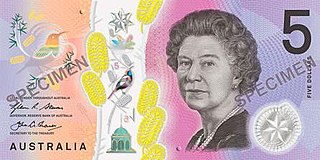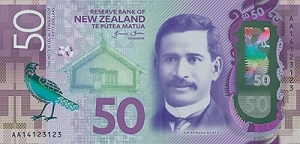History
Before 1934, a number of trading banks issued their own banknotes in New Zealand and were not obligated to accept each other's banknotes. By the 1920s there was a general desire to have a single national currency. Accordingly, the Reserve Bank was established in 1934 as the sole authority for issuing New Zealand's national banknotes, while the New Zealand Treasury had responsibility for issuing new coins. [2] [3] New Zealand was the last British dominion to establish a national currency. [3]
The Reserve Bank has released seven different issues of New Zealand bank notes; two issues took place when the New Zealand pound was the national currency, and the remaining five issues have taken place since New Zealand switched to decimal currency in 1967. [2]
First and second series: Pre-decimal
The first New Zealand banknotes were released on 1 August 1934, signed by the first Governor of the Reserve Bank, Leslie Lefeaux. The first issue was printed by Thomas de la Rue and his company based in London, and included notes with the denomination of 10/- (ten shillings), £1 (one pound), £5 and £50. The banknotes were all the same size: 7 by 3.5 inches (178 mm × 89 mm). [2]
The first issue notes were designed at short notice and intended to be temporary for that reason. The features were based on notes already in circulation and included Māori iconography; each note featured a kiwi, the New Zealand coat of arms, Mitre Peak, and a portrait of King Tāwhiao, the second Māori king. [3] [4]
The second series notes were first issued on 6 February 1940, marking the centenary of the Treaty of Waitangi. The designs were largely developed by a Reserve Bank Committee led by Lefeaux with consultants including Sir James Shelley. The design and colours for the 10/- and £50 notes were changed, and a £10 note was introduced. A portrait of Captain James Cook replaced the portrait of King Tāwhiao and Māori iconography was less prominent than it had been in the second issue, although the King remained on the notes' watermark and a vignette of the signing of the Treaty was added to the 10/- note. [2] [3] [4]
The British monarch did not feature on any of the first or second issue banknotes, because an appropriate engraving of George VI was not available in time. [3]
Third series: 1967–1981
Decimalisation of the New Zealand currency occurred on 10 July 1967, when the New Zealand pound was replaced by the New Zealand dollar. On the same day, new decimal banknotes were introduced to replace the existing pound banknotes, in denominations of $1, $2, $5, $10, $20, and $100. [2] [4]
The designs were selected by a six-person design committee appointed in 1964, which included Alexander McLintock, Stewart Bell Maclennan and Professor John Simpson, Dean of the Faculty of Fine Arts at the University of Canterbury. [4] All the notes of this series had Queen Elizabeth II on the front, and a watermark of Captain Cook. They also had a New Zealand bird and the plant most closely associated with that species on the back. [2] [4] The colour scheme on all but the five-dollar note (which was an entirely new denomination, worth £2 10s) remained the same on equivalent pound and dollar notes to ease the transition (e.g. £10 and $20 were both green).[ citation needed ]
Fourth series: 1981–1991
In late 1981 the Reserve Bank switched to a different printer, the New Zealand branch of Bradbury Wilkinson & Co, which meant that new printing plates had to be made. [2] [4] The only changes with this series were minor drawing changes and an update to the portrait of Elizabeth II. [2] [4] Elizabeth II now faced forward, rather than to the left. It was based upon a photograph by Peter Grugeon, with the Queen wearing Grand Duchess Vladimir's tiara and Queen Victoria's golden jubilee necklace. [5] The fifty-dollar note was introduced in 1983 as part of this series as a result of inflation and to fill the gap between the twenty-dollar and one-hundred-dollar notes. [2]
A commemorative ten-dollar note was issued in 1990 to commemorate 150 years since the signing of the Treaty of Waitangi. [6]
The one-dollar and two-dollar notes were discontinued in 1991 and replaced by the one-dollar and two-dollar coins, both coloured gold. [3] Requests for a donation (koha) at an event or other occasion are often framed as requests for a "gold coin donation".[ citation needed ]
Fifth series: 1992–1999
New Zealand's banknotes were completely re-designed in 1991 to introduce uniquely New Zealand designs. The new series featured notable New Zealanders on the front, with the exception of the twenty-dollar note, which still featured Elizabeth II. The reverse sides were redesigned to incorporate a natural New Zealand scene, with a native New Zealand bird in the foreground. The Queen replaced Captain Cook as the image for the watermark. [2] [4] A notable feature of the new series was the inclusion of the portrait of Sir Edmund Hillary on the front of the five-dollar note. He was the only living person to appear on a New Zealand banknote during his lifetime (other than monarchs). [4] [7]
The banknote redesign was reportedly required because when the Reserve Bank governor Don Brash told the existing printer, Bradbury Wilkinson & Co, that the bank proposed to put the printing of banknotes (its largest cost) out to tender, the firm said that they owned the copyright on the plates. The decision was made to re-design the banknotes in order to avoid copyright issues. After the tender, Bradbury Wilkinson & Co retained printing rights, but the price per note was significantly less. [8]
Sixth series: 1999–2014
In 1999, New Zealand changed from paper banknotes to polymer banknotes. The change increased the life of the banknotes and also allowed new and improved security features to prevent counterfeiting. The overall design of the notes remained unchanged albeit for slight modifications for the new security features. [2]
The Reserve Bank issued another special edition of the ten-dollar note in 1999 to celebrate the new millennium in New Zealand. Over three million of these notes were issued into general circulation, and the Reserve Bank began withdrawing them in 2002. They are now collectors' items and as of 2020 can sell for as much as NZ$88. [9]
Seventh series: 2015 onwards

In July 2011, the Reserve Bank of New Zealand announced that a new issue of banknotes would be released for circulation from 2015. [10] [11] The new five-dollar and ten-dollar notes were released in October 2015, and the new twenty-dollar, fifty-dollar and one-hundred-dollar notes were released in May 2016. The Reserve Bank termed the issue the "Brighter Money" series. [12]
The new series was introduced in order to add more security features to New Zealand banknotes. As surveys showed that the New Zealand public were generally content with the note design, very few design changes were made, and the designs remained substantially the same as the Series 5 designs. The notes were brighter in colour and featured the Māori translation of Reserve Bank (Te Pūtea Matua), and "New Zealand, Aotearoa" on the back. [4] The new notes filtered out slowly because they were only issued as returned older notes came in. Polymer banknotes last four times as long as cotton banknotes, [13] and as of July 2018 many notes from the sixth series could still be found in circulation. [14]
Future
After the death of Queen Elizabeth II in September 2022, the Reserve Bank said it would exhaust its existing stocks of twenty-dollar notes before introducing new twenty-dollar notes featuring King Charles III. Based on current stock levels, this would likely be several years away. [15]


















